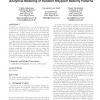Free Online Productivity Tools
i2Speak
i2Symbol
i2OCR
iTex2Img
iWeb2Print
iWeb2Shot
i2Type
iPdf2Split
iPdf2Merge
i2Bopomofo
i2Arabic
i2Style
i2Image
i2PDF
iLatex2Rtf
Sci2ools
PEWASUN
2006
ACM
2006
ACM
Analytical modeling of random waypoint mobility patterns
Mobility, in its various forms, is one of the sources of several technical challenges being addressed in the last years to achieve a more flexible computing and communication infrastructure. In this context, the study and characterization of node mobility in wireless networks is extremely important to foresee the node distribution in the network, thus enabling the creation of suitable models and a more accurate prediction of performance and dependability levels. In this paper we adopt a Markovian formalism, namely SAN (Stochastic Automata Networks), to model and analyze various aspects of the Random Waypoint mobility pattern. We first show the compatibility of our results with existing continuous state studies and then we extend the analysis of the Random Waypoint by addressing different specific, but far from irrelevant, aspects of the mobility pattern. In this sense, this contribution shows both results for this mobility pattern as well as the suitability of the SAN formalism to...
Mobility Patterns | PEWASUN 2006 | Stochastic Automata Networks | Waypoint Mobility Pattern | Wireless Networks |
| Added | 14 Jun 2010 |
| Updated | 14 Jun 2010 |
| Type | Conference |
| Year | 2006 |
| Where | pewasun |
| Authors | Fábio Delamare, Fernando Luís Dotti, Paulo Fernandes, Cristina M. Nunes, Luciano C. Ost |
Comments (0)

